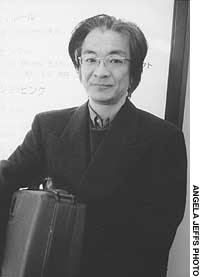 Shun Akiba, a former high-level foreign reporter, has identified hundreds of
kilometers of Tokyo tunnels whose purpose is unknown and whose very existence is
denied.
Shun Akiba, a former high-level foreign reporter, has identified hundreds of
kilometers of Tokyo tunnels whose purpose is unknown and whose very existence is
denied.SEVEN RIDDLES SUGGEST SECRET CITY BENEATH TOKYO
Saturday, March 1, 2003
 Shun Akiba, a former high-level foreign reporter, has identified hundreds of
kilometers of Tokyo tunnels whose purpose is unknown and whose very existence is
denied.
Shun Akiba, a former high-level foreign reporter, has identified hundreds of
kilometers of Tokyo tunnels whose purpose is unknown and whose very existence is
denied.
During the Gulf War in 1991, Shun Akiba was one of only two foreign journalists reporting from Baghdad, along with Peter Arnett of CNN. With such experience and expertise, it would be reasonable to imagine him in great demand right now. Wrong.
Shun Akiba, a former high-level foreign reporter, has identified hundreds of kilometers of Tokyo tunnels whose purpose is unknown and whose very existence is denied.
Shun is on some kind of invisible blacklist. His book "Teito Tokyo Kakusareta Chikamono Himitsu" ("Imperial City Tokyo: Secret of a Hidden Underground Network"), published by Yosensha in late 2002, is already in its fifth edition. Yet Shun has found it impossible to get the media to take serious note, write reviews or offer interviews.
This is very strange because he has a great story -- evidence of a network of tunnels and possibly an underground city beneath Tokyo that the public is totally unaware of. "Why am I ignored? Can I be on to something, and there is a conspiracy to silence me? I believe so."
Shun's father was a journalist with the Asahi newspaper. "I hated his lifestyle. Preferring to work in entertainment, I steered myself into TV. Finding myself in the news section, I decided to go abroad."
Working for Asahi TV, he covered the U.S. military invasion of Panama, leftwing guerrilla actions in Peru, peacekeeping activities in Cambodia, and the Gulf War as a foreign correspondent. Then in 1996, he decided to go freelance, recasting himself as a writer. "I wrote a mystery novel, called 'Director's Cut,' never thinking I'd go back to journalism."
What changed his life was finding an old map in a secondhand bookstore. Comparing it to a contemporary map, he found significant variations. "Close to the Diet in Nagata-cho, current maps show two subways crossing. In the old map, they are parallel."
The journalist in him taking over, he sought out construction records. When responses proved defensive and noncooperative -- "lips zipped tight" -- he set out to prove that the two subway tunnels could not cross: "Engineering cannot lie."
This inconsistency is just the first of seven riddles that he investigates in his book. The second reveals a secret underground complex between Kokkai-gijidomae and the prime minister's residence. A prewar map (riddle No. 3) shows the Diet in a huge empty space surrounded by paddy fields: "What was the military covering up?" New maps (No. 4) are full of inconsistencies: "People are still trying to hide things."
http://search.
japantimes. co.jp/member/ member.html? fl20030301a1. htm&1=0